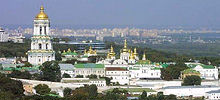Kievtown.net
Kiev travel guide

Kievtown.net Kiev travel guide |
 |
|||
SIGHTS: Monument to Bogdan Khmelnitsky Monument to prince Vladimir
|
Address: Park at Vladimirskaya gorka, Threhsvyatitelskaya street How to get: nearest metro stations: Pochtovaya ploshad’ (Post square), Maydan Nezalzhnosti
Monument to Prince Vladimir, the Baptist of Russia, is located at the park of Vladimirskaya Gorka. St. Vladimir’s figure rises above steep Dnieper bank. Prince holds a cross in the right hand and a princely cap in the left. The pedestal is constructed of brick and reveted with pig-iron. It reminds a chapel by form. The high relief placed at the pedestal of the monument, represents the episode of christening of Kievers. The pedestal appearance is supplemented with images of stars and crosses - symbols of christening by fire and sword, Archangel Michael, who is Kiev patron and is represented at the city arm, weapon, torch as an education symbol, and fertility symbols also. Huge cross, held by Vladimir, was equipped by gas torches so that the figure could be seen at night. Later those gas torches were replaced with electric lamps. Before the monument to Prince Vladimir appeared at Vladimirskaya Gorka, this place was called Mihaylovskaya gorka, by the name of St.Michael’s monastery, owned the land. In the middle of 19 century Mihaylovskaya gorka slopes were covered by vineyards. After the land became the city property, reconstruction of Mihaylovskaya gorka began. The park, resembling Swiss mountains, was organized here: lawns were laid out, avenues made and benches placed; even a tea pavilion and a fountain were constructed. Park terraces were connected with brick paths and stairs. Installation of the monument to Vladimir in 1853 became a part of development of Mihaylovsky Park. In the beginning, in 1840, a slope was strengthened and equipped with a terrace. It was decided to establish the monument to Prince Vladimir at the place where the christening of Russian people happened. The sculpture was created in Petersburg. Sculptors Peter Klodt and Vladimir Demut-Malinovsky, engineer Alexander Ton worked on it. This version of the monument was chosen and approved by tsar Nikolay I. Just one delay with the monument placing was because of the protest of Kiev metropolitan Philaret Amfiteatrov. He refused to sanctify the monument to Prince Vladimir for the reason that it doesn’t benefit to establish an idol in memory of the one who overthrew idols.
Prince Vladimir (Vasily in Christianity), called by Prince Vladimir Krasnoe Solnishko (Red Sun), was notable for cruel temper and corruption nature till Christianity adoption. Having dethroned his brother Jaropolk in 978 and having captured Kiev, Vladimir canceled out all brother’s attempts to adopt Christianity. This time can be named the period of pagan reaction. Vladimir erected a pantheon for idols of the main pagan gods Perun, Hors, Dazhdbog, Stribog, Semargl and Mokosha. Human sacrifices to gods (as a rule, they were captured enemies) became the practice. It is known that Vladimir had several hundreds of concubines in different cities, and also several wives in accordance with pagan traditions. But later, when Russia became quite outstanding state known in Europe, the necessity to choose a religion, capable to involve influential allies, or to reform paganism, appeared. As a result, the choice was made for Christianity. Traditionally year 998 is considered to be the date of Christening of Russia. It is known, that exactly under Vladimir's decree violent propagation of literacy began. Despite obvious progressiveness of the enterprise, people gave an alerted reception and sometimes arouse counteraction: "He sent to collect people best children and intend them for book learning. These children mothers cried about them; because they were not the faithful yet and cried about them as about the dead."
Legends and myths:During the Great Patriotic War the German administration decided to destroy the monument to Prince Vladimir. Kiev inhabitance convinced Germans that they mustn’t blow up a monument, as it covers a well with metro waters. It takes only to touch the monument and rough waters would flood Kiev. It is more modern variant of the legend about the sea, hidden under Andreevskaya church.
|
Àâèàáèëåòû äåøåâî
buruki.ru - äåøåâûå àâèàáèëåòû |
|||||